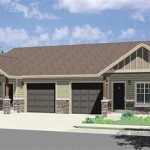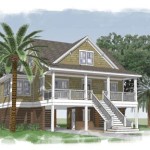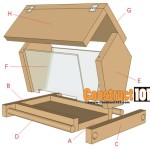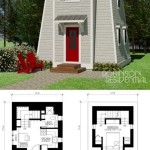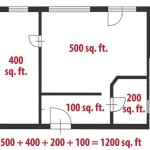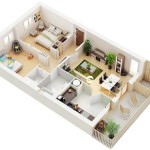Neoclassical Home Plans: An Enduring Architectural Style
Neoclassical home plans represent a revival of interest in the aesthetics and principles of classical Greek and Roman architecture. This style, which gained prominence in the mid-18th century, emphasizes symmetry, order, and a restrained elegance. It's a reaction against the perceived excesses of the Baroque and Rococo periods, seeking instead a return to architectural purity and timeless beauty. Neoclassical designs are not mere imitations of ancient structures but rather interpretations that adapt classical elements to modern living and building practices. The enduring appeal of Neoclassical architecture stems from its ability to project a sense of sophistication, stability, and enduring value.
The influence of Neoclassical architecture can be observed in numerous iconic buildings across the globe, from government structures and museums to grand residences. This architectural style is characterized by its use of classical orders, symmetrical facades, and meticulously planned proportions. While it may appear austere compared to more ornate styles, the beauty of Neoclassical design lies in its subtle details and harmonious composition.
Designing a Neoclassical home requires careful consideration of various architectural elements and principles. The selection of appropriate materials, the application of classical orders, and the attention to detail are crucial for creating a truly authentic Neoclassical aesthetic. A well-executed Neoclassical home plan will not only capture the visual appeal of the style but also provide a comfortable and functional living space for modern occupants.
Key Characteristics of Neoclassical Home Plans
Understanding the key characteristics of Neoclassical architecture is essential for planning a successful home design project. These characteristics encompass various aspects, from the overall layout to the specific decorative elements. By adhering to these principles, architects and homeowners can create a residence that reflects the enduring beauty and sophistication of the Neoclassical style.
One of the most fundamental aspects of Neoclassical design is its emphasis on symmetry. This is evident in the balanced facade, where windows and doors are typically arranged in a mirrored pattern around a central axis. The symmetrical layout extends to the interior spaces, with rooms often mirroring each other on either side of a central hallway or foyer. This creates a sense of order and harmony that is characteristic of the Neoclassical style.
The application of classical orders is another defining feature of Neoclassical architecture. These orders, which include Doric, Ionic, and Corinthian, dictate the proportions and details of columns, pilasters, and entablatures. Each order has its own distinct characteristics, with Doric being the simplest and most austere, Ionic featuring volutes or scroll-like ornaments, and Corinthian characterized by elaborate acanthus leaf carvings. The choice of order will depend on the overall design and the desired level of ornamentation.
Proportion and balance are paramount in Neoclassical design. Architects meticulously plan the dimensions of each element to create a harmonious composition. The golden ratio, a mathematical proportion that has been used in art and architecture for centuries, is often employed to achieve a sense of visual perfection. This attention to detail ensures that the building appears aesthetically pleasing and well-proportioned.
The use of materials in Neoclassical construction typically revolves around natural stone, brick, and stucco. These materials contribute to the style's sense of permanence and solidity. Stone is often used for columns, pilasters, and other decorative elements, while brick and stucco are commonly used for the main body of the building. The choice of materials should be consistent with the overall aesthetic and the desired level of grandeur.
Restrained ornamentation is a hallmark of Neoclassical architecture. While classical elements such as columns and pediments are incorporated, they are typically used in a more subtle and understated manner than in earlier classical styles. Ornamentation is often focused on specific areas, such as the entrance or the cornice, and is carefully chosen to enhance the overall design without overwhelming it.
Interior Design Considerations for Neoclassical Homes
Extending the Neoclassical aesthetic to the interior of a home requires careful planning and attention to detail. The interior design should complement the architectural style and create a cohesive and harmonious living space. This involves selecting appropriate color palettes, furniture, and decorative elements that reflect the elegance and sophistication of the Neoclassical period.
Color palettes in Neoclassical interiors typically consist of muted and refined tones. Soft whites, creams, grays, and pale blues are commonly used to create a sense of airiness and spaciousness. Accent colors, such as gold, silver, and burgundy, can be added to highlight specific architectural features or decorative elements. The overall color scheme should be subtle and elegant, avoiding overly bright or bold hues.
Furniture in Neoclassical homes is characterized by its elegant lines and refined details. Pieces are often made of high-quality materials such as mahogany, walnut, or cherry wood. Upholstery typically features classic patterns and textures, such as damask, brocade, and silk. Common furniture styles include Empire, Directoire, and Louis XVI, all of which share a common emphasis on symmetry, proportion, and elegance. Avoid overly ornate or extravagant furniture styles that may clash with the Neoclassical aesthetic.
Lighting plays a crucial role in enhancing the ambiance of a Neoclassical interior. Chandeliers, sconces, and table lamps are often used to provide both ambient and accent lighting. Fixtures should be chosen to complement the overall style, with crystal chandeliers and brass sconces being popular choices. The placement of lighting should be carefully considered to highlight architectural features and create a warm and inviting atmosphere.
Decorative elements in Neoclassical homes should be chosen to enhance the overall elegance and sophistication of the space. Mirrors, paintings, sculptures, and decorative vases are commonly used to add visual interest and create a sense of refinement. Artwork should be carefully selected to complement the color palette and style of the room. Consider incorporating classical motifs, such as Greek key patterns or acanthus leaf carvings, into the decorative scheme.
Flooring materials in Neoclassical homes should be durable and elegant. Marble, hardwood, and tile are common choices, with marble being particularly popular for its timeless beauty and durability. Area rugs can be used to add warmth and texture to the space, with Persian rugs and other classic patterns being appropriate choices. The flooring should be chosen to complement the overall color scheme and style of the room.
Adapting Neoclassical Home Plans for Modern Living
While Neoclassical architecture evokes a sense of history and tradition, it's important to adapt these plans to meet the needs and expectations of modern living. This involves incorporating contemporary amenities and technologies while preserving the essential characteristics of the Neoclassical style. Successfully blending the old and the new requires careful consideration and a commitment to maintaining the integrity of the design.
One of the key challenges in adapting Neoclassical home plans for modern living is incorporating contemporary amenities without compromising the architectural style. This includes integrating modern kitchens, bathrooms, and entertainment systems seamlessly into the design. Consider concealing modern appliances behind custom cabinetry that matches the Neoclassical aesthetic. Smart home technologies can be integrated discreetly, ensuring that they don't detract from the overall elegance of the space.
Another important consideration is energy efficiency. Modern homes are expected to be energy-efficient and environmentally friendly. This can be achieved by incorporating features such as high-efficiency windows, insulation, and HVAC systems. Solar panels can be installed discreetly on the roof, minimizing their visual impact on the Neoclassical facade. Sustainable materials can be used throughout the construction process to reduce the environmental footprint of the home.
Space planning is also crucial for adapting Neoclassical home plans to modern living. While traditional Neoclassical homes often featured formal and compartmentalized spaces, modern homeowners typically prefer more open and flexible layouts. Consider incorporating open-concept living areas that allow for seamless flow between the kitchen, dining room, and living room. This can be achieved while still maintaining the symmetrical layout and elegant details that are characteristic of the Neoclassical style.
Accessibility is another important consideration for modern homeowners. Neoclassical homes can be adapted to be more accessible by incorporating features such as ramps, wider doorways, and accessible bathrooms. This can be achieved without compromising the architectural style by carefully integrating these features into the design. Consider using universal design principles to create a home that is comfortable and accessible for people of all ages and abilities.
Ultimately, adapting Neoclassical home plans for modern living requires a balance between preserving the historical integrity of the style and incorporating contemporary amenities and technologies. By carefully considering these factors, architects and homeowners can create a residence that is both beautiful and functional, offering the best of both worlds.

Dream Neoclassical House Plans Floor Designs

Luxury Home Plans For Neoclassical Cau With A Courtyard

Neoclassic House Plans Sater Design Collection

Dunleith House Plan De003 Design Evolutions Inc Ga

Neoclassical Home Floor Plans Architectural House Designs

Minard Lafever Modern Builder S Guide Architectural Floor Plans Neoclassical Architecture

Luxury Home Plans For Neoclassical Cau With A Courtyard

Neoclassic House Plans Sater Design Collection

Neoclassical Style House Floor Plans Designs

The Beautiful Home House Plans
Related Posts

